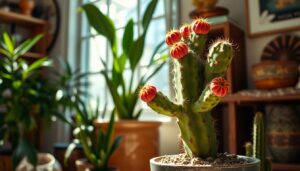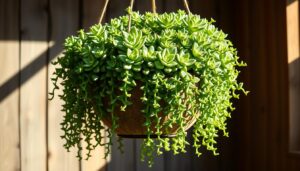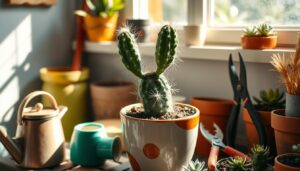Introduction
Welcome to the lush world of Angel Wing Begonias, where vibrant colors and delicate foliage converge to create a captivating botanical display. Whether you’re a seasoned plant enthusiast or a novice green thumb, nurturing these graceful beauties can be a rewarding journey filled with growth and splendor.
In this comprehensive guide, we’ll delve into the art of Angel Wing Begonia care, exploring everything from optimal growing conditions to troubleshooting common issues. From their origins in the tropical regions of South America to their widespread popularity as houseplants, Angel Wing Begonias have earned a special place in the hearts of plant enthusiasts worldwide.
Join us as we uncover the secrets to cultivating thriving Angel Wing Begonias, unlocking the potential to transform your living space into a verdant oasis of natural beauty and tranquility. Let’s embark on this botanical adventure together, nurturing our begonias with care and admiration every step of the way.
Understanding Angel Wing Begonias
Angel Wing Begonias, known scientifically as Begonia coccinea, belong to the Begoniaceae family and are native to the lush forests of Brazil and other tropical regions of South America. These begonias earned their name from the distinctive shape of their leaves, which resemble the outstretched wings of angels, adorned with intricate patterns and striking colors.
Characteristics:
Angel Wing Begonias are renowned for their unique foliage, which can vary in size, shape, and coloration depending on the cultivar. However, they typically feature elongated, asymmetrical leaves with serrated edges, ranging from deep green to bronze or silver hues. The leaves often exhibit contrasting veins and spots, adding to their visual appeal.
Varieties:
There are numerous cultivars of Angel Wing Begonias, each with its own distinct characteristics and growth habits. Some popular varieties include:
- Begonia ‘Lucerna’: This cultivar boasts large, glossy leaves with silver-green markings and vibrant red undersides, creating a stunning contrast.
- Begonia ‘Sophia’: Known for its compact growth habit and delicate pink flowers, ‘Sophia’ adds a touch of elegance to any indoor garden.
- Begonia ‘Corallina de Lucerna’: With its coral-colored flowers and lush foliage, ‘Corallina de Lucerna’ is a favorite among begonia enthusiasts for its graceful beauty.
Growing Conditions:
To thrive, Angel Wing Begonias require a balance of light, humidity, and moisture. Here’s a breakdown of their ideal growing conditions:
Aspect | Description |
Light | Indirect sunlight or filtered light. Avoid direct sun exposure, as it can scorch the delicate foliage. |
Temperature | Moderate temperatures between 65°F to 75°F (18°C to 24°C). Avoid extreme fluctuations and drafts. |
Humidity | High humidity levels, preferably between 50% to 60%. Consider using a humidifier or pebble tray. |
Watering | Keep the soil consistently moist but not waterlogged. Allow the top inch of soil to dry out between waterings. |
Soil | Well-draining potting mix rich in organic matter. A blend of peat moss, perlite, and compost works well. |
Propagation:
Angel Wing Begonias can be propagated through stem cuttings or leaf cuttings. Here’s a simple guide to propagation:
- Select a healthy stem or leaf cutting with at least one node.
- Dip the cut end in rooting hormone (optional) to encourage root development.
- Plant the cutting in a small pot filled with moist potting mix.
- Place the pot in a warm, humid environment with indirect light.
- Keep the soil consistently moist and watch for signs of new growth.
Care and Maintenance Tips
Caring for Angel Wing Begonias is a delightful endeavor, offering the opportunity to connect with nature and witness the beauty of growth firsthand. To ensure your begonias thrive and flourish, it’s essential to provide them with the proper care and maintenance. Here are some expert tips to keep your Angel Wing Begonias happy and healthy:
- Light and Temperature:
Angel Wing Begonias prefer bright, indirect light, such as that filtered through sheer curtains or provided by fluorescent grow lights. Avoid exposing them to direct sunlight, as this can scorch their delicate leaves. Maintaining moderate temperatures between 65°F to 75°F (18°C to 24°C) is ideal for these tropical plants. Avoid placing them near drafts or vents, as sudden temperature fluctuations can stress the plants.
- Watering and Humidity:
Proper watering is crucial for the health of Angel Wing Begonias. Keep the soil consistently moist but not waterlogged. Water thoroughly when the top inch of soil feels dry to the touch, allowing excess water to drain away freely. Avoid letting the soil dry out completely or sitting in water, as both extremes can harm the plants. Maintaining high humidity levels of 50% to 60% is essential, especially in indoor environments. You can increase humidity by using a humidifier, placing the plants on a pebble tray filled with water, or misting them regularly.
- Soil and Fertilization:
Use a well-draining potting mix rich in organic matter, such as a blend of peat moss, perlite, and compost. Repot your Angel Wing Begonias every year or two to refresh the soil and provide them with fresh nutrients. During the growing season, fertilize your begonias every two to four weeks with a balanced liquid fertilizer diluted to half strength. Reduce fertilization during the winter months when the plants are dormant.
- Pruning and Maintenance:
Regular pruning helps promote bushy growth and keeps Angel Wing Begonias looking tidy and healthy. Remove any yellowing or dead leaves promptly to prevent the spread of disease and maintain optimal airflow around the plant. You can also pinch back leggy stems to encourage branching and compact growth. Inspect your begonias regularly for signs of pests, such as aphids or mealybugs, and treat them promptly with organic insecticidal soap or neem oil if necessary.
Troubleshooting Common Issues
While Angel Wing Begonias are generally resilient plants, they may encounter occasional challenges that require attention and intervention. Understanding and addressing these common issues promptly can help maintain the health and vitality of your begonias. Here are some troubleshooting tips for addressing common problems:
- Yellowing Leaves:
Yellowing leaves are often a sign of overwatering or underwatering. To determine the cause, check the moisture level of the soil and adjust your watering frequency accordingly. If the soil is waterlogged, allow it to dry out before watering again. Conversely, if the soil is dry, water your begonias thoroughly and ensure proper drainage. Yellowing leaves can also indicate nutrient deficiencies, so consider fertilizing your plants with a balanced fertilizer to replenish essential nutrients.
- Leaf Browning or Curling:
Browning or curling of leaves can be caused by insufficient humidity or exposure to dry air. Increase humidity around your begonias by misting them regularly, using a humidifier, or placing a tray of water and pebbles near the plants. Avoid placing your begonias near heaters or air conditioners, as these can create dry conditions that stress the plants. Additionally, ensure adequate airflow around the plants to prevent stagnant air, which can contribute to leaf problems.
- Pest Infestations:
Angel Wing Begonias are susceptible to pest infestations, including aphids, mealybugs, spider mites, and scale insects. Inspect your plants regularly for signs of pests, such as distorted leaves, sticky residue, or visible insects. If pests are present, treat your begonias with organic insecticidal soap, neem oil, or horticultural oil, following the manufacturer’s instructions carefully. Consider isolating infested plants to prevent the spread of pests to other plants in your collection.
- Fungal Diseases:
Fungal diseases, such as powdery mildew or botrytis blight, can affect Angel Wing Begonias, especially in humid conditions or overcrowded growing spaces. To prevent fungal diseases, provide adequate spacing between plants to promote airflow and reduce humidity around the foliage. Avoid overhead watering, as wet foliage can encourage fungal growth. If fungal diseases are present, remove affected plant parts promptly and apply a fungicidal treatment to prevent further spread.
- Leggy Growth:
Leggy growth, characterized by long, thin stems and sparse foliage, can occur when begonias receive insufficient light or are not pruned regularly. To encourage bushy growth, provide your begonias with bright, indirect light and prune them regularly to promote branching. Pinch back leggy stems to encourage lateral growth and remove any overcrowded or weak growth to maintain a compact, healthy plant.
By addressing these common issues proactively and implementing appropriate solutions, you can help your Angel Wing Begonias thrive and flourish, ensuring a stunning display of foliage and blooms for years to come. Remember to observe your plants closely, adjust care practices as needed, and enjoy the rewarding experience of nurturing these beautiful botanical treasures.
Propagation Techniques
One of the joys of cultivating Angel Wing Begonias is the opportunity to propagate new plants, expanding your collection and sharing the beauty of these exquisite specimens with others. Propagation can be achieved through various methods, including stem cuttings, leaf cuttings, and division. Below, we’ll explore each technique in detail, providing step-by-step instructions for successful propagation:
- Stem Cuttings:
Stem cuttings are a popular and reliable method of propagating Angel Wing Begonias, allowing you to create new plants from existing ones quickly. Follow these steps to propagate begonias from stem cuttings:
- Select a healthy stem from the parent plant, preferably one with several nodes and no flowers.
- Use a clean, sharp pair of scissors or pruning shears to make a diagonal cut just below a node.
- Remove any leaves from the lower half of the cutting to reduce moisture loss and encourage rooting.
- Dip the cut end of the stem cutting into a rooting hormone powder to stimulate root development (optional).
- Plant the cutting in a small pot filled with moistened potting mix, ensuring that at least one node is buried in the soil.
- Place the pot in a warm, humid environment with bright, indirect light.
- Keep the soil consistently moist but not waterlogged, and mist the cutting regularly to maintain high humidity levels.
- Within a few weeks to a couple of months, roots should develop, and new growth will emerge from the cutting, indicating successful propagation.
- Leaf Cuttings:
Leaf cuttings offer another effective method of propagating Angel Wing Begonias, particularly when stem cuttings are unavailable or impractical. Follow these steps to propagate begonias from leaf cuttings:
- Select a healthy, mature leaf from the parent plant, preferably one with prominent veins and no signs of damage.
- Use a clean, sharp knife or scissors to make a clean cut along the petiole (leaf stem), ensuring that a portion of the petiole remains attached to the leaf.
- Insert the cut end of the leaf cutting into a small pot filled with moistened potting mix, burying the petiole in the soil and allowing the leaf blade to rest on the surface.
- Gently press the soil around the base of the leaf cutting to secure it in place.
- Place the pot in a warm, humid environment with bright, indirect light, and maintain consistent moisture levels in the soil.
- Over time, roots will develop from the base of the leaf cutting, and new plantlets will emerge from the leaf blade, signaling successful propagation.
- Division:
Division is a straightforward method of propagating Angel Wing Begonias, particularly for plants that have become large or overcrowded. Follow these steps to propagate begonias through division:
- Carefully remove the parent plant from its pot, taking care not to damage the roots.
- Gently tease apart the root ball, dividing it into smaller sections, each with its own stems and roots.
- Trim away any damaged or unhealthy roots with clean, sharp scissors or pruning shears.
- Plant each divided section in its own pot filled with fresh potting mix, ensuring that the roots are spread out evenly and covered with soil.
- Water the newly potted divisions thoroughly and place them in a warm, humid environment with bright, indirect light.
- Monitor the divisions closely, keeping the soil consistently moist and misting the foliage regularly to maintain high humidity levels.
- Within a few weeks, the divisions should establish roots and begin producing new growth, indicating successful propagation.
Conclusion
Angel Wing Begonias stand as timeless symbols of natural beauty and elegance, captivating plant enthusiasts with their graceful foliage and charming blooms. Throughout this guide, we’ve explored the art of Angel Wing Begonia care, from understanding their origins and characteristics to mastering propagation techniques and troubleshooting common issues.
As we’ve discovered, providing optimal growing conditions, including bright, indirect light, consistent moisture, and high humidity, is essential for the health and vitality of Angel Wing Begonias. By maintaining a balance of these factors and adapting care practices as needed, we can create an environment where our begonias thrive and flourish.
Furthermore, the propagation of Angel Wing Begonias offers an enriching experience, allowing us to witness the magic of new growth and share the joy of gardening with others. Whether through stem cuttings, leaf cuttings, or division, propagating begonias opens doors to endless possibilities, fostering a deeper connection with these enchanting plants.
As stewards of nature, let us continue to nurture our Angel Wing Begonias with care and appreciation, embracing the beauty they bring into our lives. Through patience, observation, and a touch of creativity, we can cultivate thriving begonia gardens that inspire and delight for generations to come. So, let us embark on this botanical journey with open hearts and green thumbs, celebrating the wonder of Angel Wing Begonias every step of the way.
Thanks you for visiting us here at the TrustedHouseplantGuide.com.The Landscape Connection is our Brick-N-Mortar Location, If you happen to be nearby we hope you will stop and see us!




